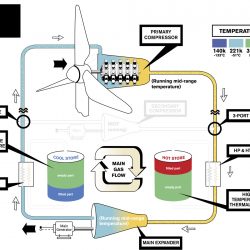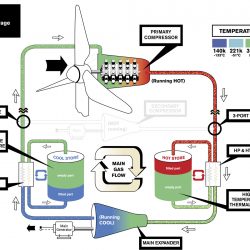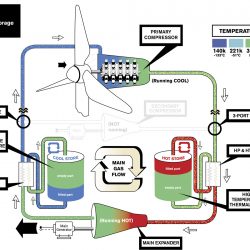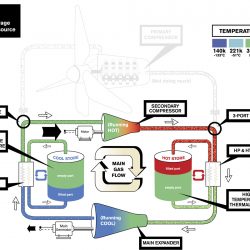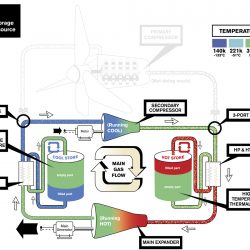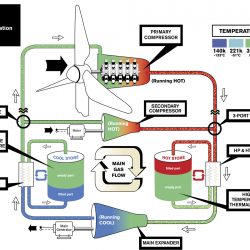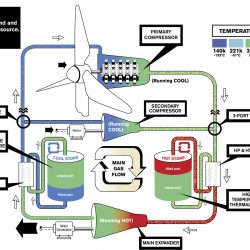Seven modes of operation
The WindTP system can be operated in any one of 7 different modes as summarised below:
MODE A – pure power transmission system
Using collected wind power directly to make electricity
MODE B – energy INTO storage
Transforming some wind power into electricity but putting most into storage
MODE C – energy FROM storage
Generating electricity where most of the energy comes from storage and a small amount from wind
MODE D – energy INTO storage minimal wind resource
Taking power from the grid and charging the store
MODE E – energy FROM storage minimal wind resource
Recovering energy from storage
MODE F – all energy INTO storage
A mix of (b) and (d) where all wind power gathered goes into storage
MODE G – energy FROM wind and FROM storage
A mix of (c) and (e) where any available wind power contributes generation
In all operating modes, gas circulates in the closed circuit – being compressed from 20bar up to 500bar and expanded again back down from 500bar to 20bar.
In mode (a), the temperature of the gas leaving the compressor(s) is the same as that entering the expander and the temperature of the gas leaving the expander is the same as that entering the compressor(s). In this mode, the electrical power being generated is similar to the power being harvested.
In modes (b), (d) and (f), gas leaving the compressor(s) is cooled before entering the expander. Heat removed from the gas is put into the hot store. Then gas leaving the expander is very cold and this coolth (coldness) is removed from the gas before the gas is returned to the compressor(s). The coolth removed from the gas is put into the cold store. In these operating modes, the total quantity of electrical power emerging from the system is substantially lower than the power entering via the compressor(s).
In modes (c), (e) and (g), gas leaving the compressor(s) is heated before entering the expander. The heat used is provided from the hot store. The gas leaving the expander is then cooled prior to returning to the compressor(s). The coolth is drawn from the cold-store in these modes. The overall effect of these modes is that the electrical power emerging from the system is significantly larger than the total work being put in.
Operating modes (d), (e), (f) and (g) all require the use of a secondary compressor. In other words, the primary compressor(s) driven directly by the wind turbine rotors are not responsible for (all of) the gas compression. Obviously, when the wind is not blowing (or is blowing too hard for the turbines to operate safely), some compression provision for operating the system must be present.
WindTP has already been studied quite intensively and you can download one analysis of its technical features from here.

